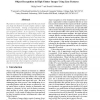Free Online Productivity Tools
i2Speak
i2Symbol
i2OCR
iTex2Img
iWeb2Print
iWeb2Shot
i2Type
iPdf2Split
iPdf2Merge
i2Bopomofo
i2Arabic
i2Style
i2Image
i2PDF
iLatex2Rtf
Sci2ools
ICCV
2005
IEEE
2005
IEEE
Object Recognition in High Clutter Images Using Line Features
We present an object recognition algorithm that uses model and image line features to locate complex objects in high clutter environments. Finding correspondences between model and image features is the main challenge in most object recognition systems. In our approach, corresponding line features are determined by a three-stage process. The first stage generates a large number of approximate pose hypotheses from correspondences of one or two lines in the model and image. Next, the pose hypotheses from the previous stage are quickly ranked by comparing local image neighborhoods to the corresponding local model neighborhoods. Fast nearest neighbor and range search algorithms are used to implement a distance measure that is unaffected by clutter and partial occlusion. The ranking of pose hypotheses is invariant to changes in image scale, orientation, and partially invariant to affine distortion. Finally, a robust pose estimation algorithm is applied for refinement and verification, star...
Approximate Pose Hypotheses | Computer Vision | ICCV 2005 | Local Image Neighborhoods | Local Model Neighborhoods | Object Recognition Algorithm | Robust Pose Estimation |
| Added | 15 Oct 2009 |
| Updated | 15 Oct 2009 |
| Type | Conference |
| Year | 2005 |
| Where | ICCV |
| Authors | Philip David, Daniel DeMenthon |
Comments (0)

